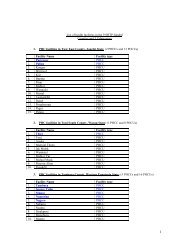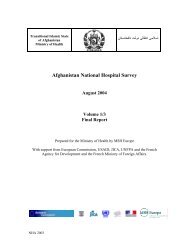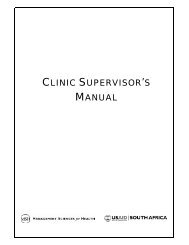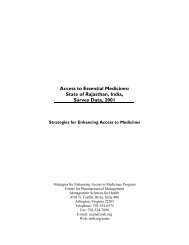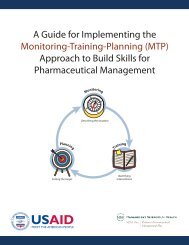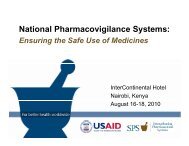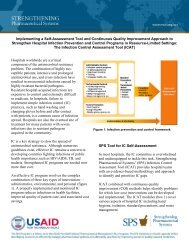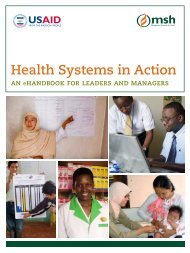Evaluation of Malawi's Emergency Human Resources Programme
Evaluation of Malawi's Emergency Human Resources Programme
Evaluation of Malawi's Emergency Human Resources Programme
You also want an ePaper? Increase the reach of your titles
YUMPU automatically turns print PDFs into web optimized ePapers that Google loves.
Management Sciences for Health<br />
From new and returning staff<br />
� The majority <strong>of</strong> new and returning staff surveyed from both MOH and CHAM<br />
(57 out <strong>of</strong> 62) stated that the salary top-ups were a key factor in the decision to<br />
join, or return to health service, although an underlying theme was that the tax on<br />
the top-up was too high; the increase in take home pay ranged from 25% to<br />
41%. 44<br />
� Many respondents cited the three-year contract as a strong incentive for reentering<br />
the health service.<br />
� Respondents overwhelmingly recommended that the government continue to<br />
recruit new and returning staff through recruitment galas.<br />
� Nearly 75% <strong>of</strong> new and returning staff surveyed (85 out <strong>of</strong> 117) indicated their<br />
intention to stay in the health sector for 10 years or longer. Most said ‘until<br />
retirement’, or ‘as long as able.’ For many, this was a change from their previous<br />
expectations.<br />
From current staff<br />
� 62 out <strong>of</strong> 90 <strong>of</strong> current staff surveyed indicated that, as a result <strong>of</strong> the top-ups,<br />
they planned to stay in the government or CHAM health services until retirement<br />
or as long as they are able. Nearly half <strong>of</strong> respondents said that this was a change<br />
from previous expectations.<br />
� Other factors that influenced health workers’ decisions to re-commit themselves<br />
to the health sector included better working conditions, such as improved<br />
promotional opportunities, housing, access to in-service training, workshops, and<br />
improved supplies.<br />
From all staff<br />
� Adequate housing remained a key concern for many staff, especially in the rural<br />
areas.<br />
� Suggestions for improvements in non-financial incentives included more<br />
educational opportunities, improved conditions <strong>of</strong> service, and improved<br />
management.<br />
� The Locum, a scheme through which medical personnel are paid additional salary<br />
to fill work shifts beyond their own when there is no other coverage, was an<br />
important financial incentive to many people but there are concerns about the<br />
quality <strong>of</strong> work under this <strong>Programme</strong>, the cost and how it is being used.<br />
Cost<br />
Expenditure under Element 1 consists <strong>of</strong> the 52% salary top-ups received by the 11<br />
cadres <strong>of</strong> staff at MOH and CHAM, 26% top-ups received by the HSAs, and<br />
44 Republic <strong>of</strong> Malawi, Malawi Health SWAp Donor Group, GTZ/UNDP. <strong>Human</strong> <strong>Resources</strong> / Capacity<br />
Development within the Health Sector: Needs Assessment Study. April 2007.<br />
EHRP <strong>Evaluation</strong> Final Report Page 30



